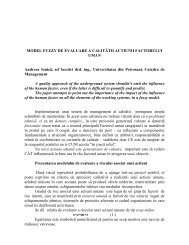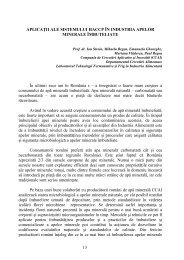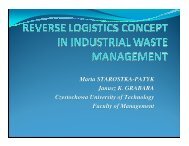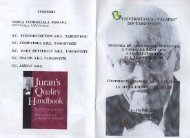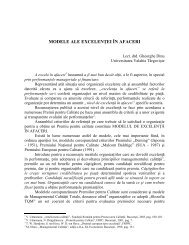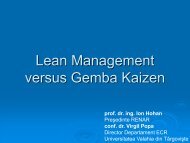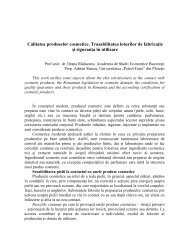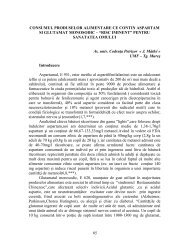Demand side management of a supply chain through ... - ecr-uvt
Demand side management of a supply chain through ... - ecr-uvt
Demand side management of a supply chain through ... - ecr-uvt
You also want an ePaper? Increase the reach of your titles
YUMPU automatically turns print PDFs into web optimized ePapers that Google loves.
SUPPLY CHAIN MANAGEMENT FOR<br />
EFFICIENT CONSUMER RESPONSE<br />
SYMPOSIUM<br />
11-12 IUNIE 2010<br />
TÂRGOVIŞTE
SCM 4 ECR SYMPOSIUM<br />
DEMAND SIDE MANAGEMENT OF A SUPPLY<br />
CHAIN THROUGH ASSORTMENT<br />
OPTIMIZATION.<br />
MERCHANDISING TOOLS<br />
Mădălina BARNA<br />
Virgil POPA
ECR Principles<br />
* Focus on consumers:<br />
At the heart <strong>of</strong> ECR is a commitment to the belief that sustained business<br />
success steams only from providing consumers with products and services that<br />
consistently meat or surpasses their demands and expectations.<br />
* Working together:<br />
The second guiding principle is the recognition that the greater<br />
consumer value can be <strong>of</strong>fered only when we work together;<br />
ECR makes the difference between<br />
demand and <strong>supply</strong>-<strong>side</strong> processes. All the<br />
processes are supported by the enablers which<br />
help to efficiently communicate the accompanying<br />
data and information.<br />
© SCM 4 ECR Mădălina Barna, Virgil Popa
Global Scorecard<br />
© SCM 4 ECR Mădălina Barna, Virgil Popa
In the ECR approach, two <strong>of</strong> the four processes needed to add value to<br />
optimize the promotion <strong>of</strong> products in the store are about:<br />
- providing a complete range <strong>of</strong> products in relation to consumer<br />
demands and that are easily purchased in stores<br />
- maintaining that level <strong>of</strong> stock allowing for full assortment <strong>of</strong> products<br />
required.<br />
Four relevant concepts:<br />
• Category Management (Efficient Assortment,<br />
Efficient Promotion, Efficient Product Introduction)<br />
• Optimal Shelf Availability<br />
• Efficient Replenishment<br />
• Collaborative Planning, Forecasting and<br />
Replenishment (CPFR)<br />
© SCM 4 ECR Mădălina Barna, Virgil Popa
Category Management<br />
The purpose <strong>of</strong> Category Management is improving the operating<br />
results <strong>of</strong> the company by focusing on the consumer. Consumers are getting<br />
more demanding and want to choose from a large assortment <strong>of</strong> products.<br />
Furthermore consumer satisfaction is a great advantage in a competitive<br />
business environment. In this view products are more than goods, which are<br />
just being sold; products also play a strategic role.<br />
Traditional Category Management (CM) is<br />
based on the ECR eight-step approach which<br />
integrates all strategic, tactical, and operational<br />
aspects <strong>of</strong> demand-<strong>side</strong> collaboration in the areas <strong>of</strong>:<br />
* Efficient Assortment<br />
* Efficient Promotion<br />
* Efficient Product Introduction<br />
© SCM 4 ECR Mădălina Barna, Virgil Popa
© SCM 4 ECR Mădălina Barna, Virgil Popa
Optimal shelf availability<br />
OSA<br />
Concept <strong>of</strong> optimal self availability (OSA)<br />
OSA is a methodology based on a simple principle measuring<br />
partial and total (complete) stock outs by comparing “real” sales <strong>of</strong> one<br />
item on a daily basis with “normal” expected sales:<br />
* one product which has normal sales displays perfect availability;<br />
* one product which has low sales is partial out <strong>of</strong> stocks;<br />
* one product which has zero sales is total stock outs.<br />
© SCM 4 ECR Mădălina Barna, Virgil Popa
Efficient replenishment<br />
ER<br />
Concept <strong>of</strong> ER<br />
“Efficient Replenishment links the consumer, retail store, retailer<br />
distribution center, and supplier into an integrated system. Accurate information<br />
flows quickly <strong>through</strong> EDI linkages between trading partners, while products flow<br />
with less handling and fewer out-<strong>of</strong>-stocks from supplier’s production line into<br />
the consumer’s basket.”<br />
The purpose <strong>of</strong> ER:<br />
Supplier and retailer work together<br />
to ensure provision <strong>of</strong> the right product, to<br />
the right place, at the right time, in the right<br />
quantity, and the most efficient manner<br />
possible.<br />
© SCM 4 ECR Mădălina Barna, Virgil Popa
Efficient Store Assortment<br />
Efficient Store Assortment is con<strong>side</strong>ring the composition <strong>of</strong><br />
a range <strong>of</strong> products and services to be complete and pr<strong>of</strong>itable and<br />
to satisfy consumers needs. The main target is to use the store<br />
space in an effective way, and the advantages are represented by a<br />
higher pr<strong>of</strong>it, better educated clients and less frequent out-<strong>of</strong>-stock.<br />
Efficient store assortment, from the consumers point <strong>of</strong> view, is a<br />
better and more flexible assortment and also less frequent out-<strong>of</strong>stock.<br />
The objectives <strong>of</strong> Efficient Assortment (EA)<br />
are to determine the optimal product that meets<br />
consumer needs as well as the efficient use <strong>of</strong> store<br />
and shelf space to achieve enhanced business<br />
results for retailers and suppliers.<br />
© SCM 4 ECR Mădălina Barna, Virgil Popa
The Right Assortment<br />
There are several important issues, which have to be taken into account<br />
when planning Efficient Store Assortment.<br />
Firstly, the cooperation between parts in the <strong>chain</strong> is <strong>of</strong> crucial importance.<br />
When several trading partners combine information about products and sales, a<br />
good overview <strong>of</strong> the market can be formed. This makes Efficient Store Assortment<br />
possible with great success.<br />
Secondly the space must be allocated on basis <strong>of</strong> correct data. Allocation <strong>of</strong><br />
space is an important key point in Efficient Store Assortment and this space is<br />
directly related to the pr<strong>of</strong>it per cubic meter. Therefore this allocation must be based<br />
on information retrieved from:<br />
- Correct scanning at the cash registers;<br />
- Historical data <strong>of</strong> sales;<br />
- Database with products in the store;<br />
- Demographically oriented data.<br />
© SCM 4 ECR Mădălina Barna, Virgil Popa
ASSORTMENT TACTICS<br />
The development <strong>of</strong> an effective assortment (balancing consumer needs<br />
with the objectives <strong>of</strong> the supplier and retailer) is one <strong>of</strong> the most important element<br />
<strong>of</strong> category <strong>management</strong>.<br />
Assortment techniques allow the establishment <strong>of</strong> consumer’s product<br />
choices and the criteria <strong>of</strong> selection or abandon.<br />
The assortment can be a very important differentiation technique for the<br />
suppliers.<br />
Efficient Assortment as an improvement<br />
concept focuses on:<br />
* con<strong>side</strong>ring the role <strong>of</strong> the category within the<br />
retailer’s portfolio<br />
* ensuring the assortment that reflects the retailer’s<br />
strategy<br />
* eliminating poorly performing SKUs or adding<br />
valuable SKUs<br />
* improving the shelf presentation <strong>of</strong> each category<br />
© SCM 4 ECR Mădălina Barna, Virgil Popa
© SCM 4 ECR Mădălina Barna, Virgil Popa
MERCHANDISING TOOLS<br />
According to American Marketing Association,<br />
merchandising is the "planning involved in marketing the<br />
right merchandise or service at the right place, at the right<br />
time, in the right quantities, and at the right price."<br />
There are two aspects <strong>of</strong> merchandising<br />
that should be con<strong>side</strong>red by the manager when<br />
developing a merchandising strategy:<br />
- creating an overall store image and<br />
market position that is appealing and attracts the<br />
targeted shoppers to the store;<br />
- presenting products in such a way that<br />
customers will want to buy them once they are in<br />
the store.<br />
© SCM 4 ECR Mădălina Barna, Virgil Popa
Merchandising objectives<br />
- support the store's image;<br />
- appeal to customers;<br />
- increase the store's sales;<br />
- attract customers to the store;<br />
- encourage customers to browse and/or purchase products;<br />
- provide an appropriate return on the investment in merchandising;<br />
- enable customers to move freely <strong>through</strong> the store;<br />
- observe the relevant occupational health and safety issues;<br />
- enable regular maintenance i.e. restocking and housekeeping; and<br />
- effectively utilize all productive selling space.<br />
An effective merchandising strategy includes a<br />
number <strong>of</strong> important elements :<br />
- store layout;<br />
- traffic flow;<br />
- space allocation;<br />
- product placement;<br />
- establishing display strategies;<br />
- planning and coordination; and<br />
- communicating strategies and standards.<br />
© SCM 4 ECR Mădălina Barna, Virgil Popa
© SCM 4 ECR Mădălina Barna, Virgil Popa
© SCM 4 ECR Mădălina Barna, Virgil Popa<br />
W
Store Operations<br />
Best practice recommendations for in-store operations<br />
© SCM 4 ECR Mădălina Barna, Virgil Popa
Indicators that can be used in evaluating merchandising plan<br />
The criteria for evaluation <strong>of</strong> the merchandising plan should be used<br />
to review the results against:<br />
- Consumer and shopper satisfaction measures;<br />
- Financial performance measures (volume, value and pr<strong>of</strong>it);<br />
- Operational efficiency measures;<br />
- External competitiveness measures (such as share or satisfaction)<br />
Indicators:<br />
- Turnover<br />
- Gross pr<strong>of</strong>it<br />
- Gross margin<br />
- Stock rotation speed<br />
- Average transaction<br />
- Market share<br />
- Gross Margin Return On Investment (GMROI)<br />
- Consumer satisfaction<br />
© SCM 4 ECR Mădălina Barna, Virgil Popa
THANK YOU FOR<br />
YOUR ATTENTION !!<br />
© SCM 4 ECR Mădălina Barna, Virgil Popa




